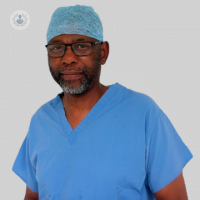What is the outlook for patients diagnosed with spider veins?
Written in association with:What exactly are spider veins, and how are they caused? Read on to find out the answers to these questions below in one of our latest medical articles, as esteemed consultant vascular surgeon, Mr Zola Mzimba, explains all.

What are spider veins?
Spider veins are visible blood vessels that have unusual patterns that can be seen beneath the surface of your skin. They mostly appear as tiny, branching lines in shades of red, blue, or purple.
Where do spider veins most typically form?
While they can form anywhere on your body, they most commonly form on our legs and sometimes our faces.
How do they form?
The formation of spider veins is caused by a mixture of weakened vein valves and damaged small blood vessels. When these tiny vessels lose their elasticity or suffer damage, they become visible as spider veins. The exact cause isn’t clear, but there are several associated risk factors, such as:
- Family history
- Hormonal changes
- Sun exposure
- Ageing
- Sedentary lifestyle
- Obesity
When should they be treated?
Spider veins are usually harmless. However, if you don't like their appearance, treatment can be offered. Many people end out seeking treatment for aesthetic reasons. Rarely, spider veins cause burning, itching, or discomfort, especially in the legs. Treatment may relieve symptoms.
What is the outlook for patients diagnosed with spider veins?
Spider veins are generally harmless, so are normally not anything to worry about. The main treatment options are sclerotherapy (injecting a solution to close off the veins) and laser therapy for spider veins on the legs.
For facial spider veins, short wave diathermy, radiofrequency, or electrocautery are recommended. Some specialists would treat spider veins on the face with sclerotherapy. However, this can carry risks of significant complications and I would not recommend this. My preferred option is electrocautery by short wave diathermy.
Lifestyle changes such as like regular exercise, elevating your legs, and wearing compression stockings, can prevent new ones from forming.
If you’d like to consult with Mr Zola Mzimba, just visit his Top Doctors profile today.


